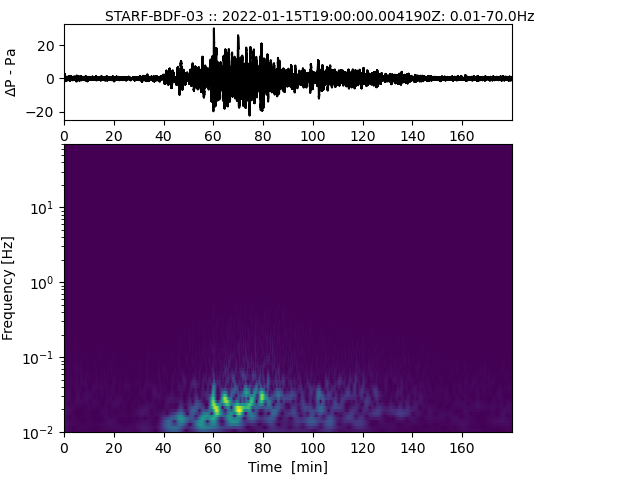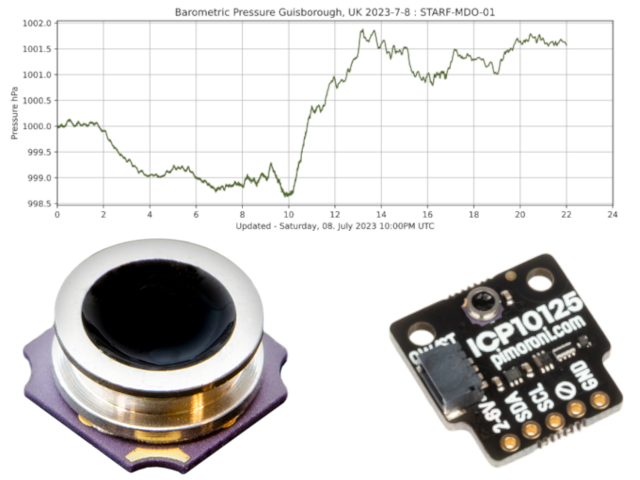|
|
Advanced Physics Projects for School & Home |
|---|---|
| opensource, real science on a budget |
|
|
Advanced Physics Projects for School & Home |
|---|---|
| opensource, real science on a budget |
| Established Published Projects | ||
|---|---|---|
|
Aurora Monitor 
Employs a low-cost fluxgate magnetometer to measure nT changes in the earth's field due to variations in the solar wind. Detects arrival of coronal mass ejections and magnetic excitation associated with the formation of aurora. .. link .. |
Infrasound Monitor 
A mems differential pressure sensor monitors low frequency atmospheric sound 0.01-~20Hz. Infrasound may be caused by tides, earthquakes, large explosions, meteor breakup, wind turbines, industrial activity.. System as also been used as a mobile sensor taking readings at windfarms, beaches and in cars. .. link .. |
Microbarometer 
An ultra precise barometric pressure and temperature sensor, typically used in drones, monitors atmospheric pressure to approx 1Pa. Observes weather systems moving over as well as large explosive events. .. link .. |
| In Progress | ||
|---|---|---|
| Computational Physics | SIDspot | Chip Design |
|
I always wanted to avoid the 'shiny box in the corner of the lab' paradigm. Beautiful expensive box arrives - Principal/Head turns up - looks impressed, school gets a bit of local press, students look bemused and for the next year it serves little more than keeping dust off the bench. We need to get down and build stuff. |
S.T.E.M. is a really boring acronym. Science, Mathematics, Computing, Electronics and Engineering are dynamic, exciting subjects. Evolving continually they reshape our lives and our world. The sciences possess excitement few other fields can match. Activities to carry this excitement and joy of discovery to students deserve a better name.
Examined courses can easily dull, especially given the pressure on exam grades as the sole measure of quality in the English state system. Indeed many believe that 'education' is synonymous with 'passing exams'. Our political masters, non of whom have a science background, have even eliminated assessed practical work from science A-levels. When I speak to educationists outside the UK they think I'm making this crap up.
---------------------------
A way to square this circle is for students to enhance their prospects and stimulate enthusiasm with non-examined project work.
I firmly believe that it is posible for a school, particularly an 11-18 school or sixth form to build an ongoing science enrichment program which permits students to engage in real research. Opening up the possibility of ongoing engagement with researchers and contributing to real papers. Indeed a few bold schools in the UK have done this such as Simon Langton Grammar School. Regretably rare in the UK this type of thing is much more common on the continent with programs such as HiSparc.
I have almost 30 years experience of teaching physics, engineering and computing from school to A-Level and beyond. Most of that time as Head of Subject and have ongoing contacts with academics in physics and engineering departments. For the past 15 years I have been actively involved in computational physics research at M.Sc, Ph.D and post-doc levels whilst teaching mostly A-level physics. Whatever changes occur in the 16-19 curriculum I am confident that universities will continue to look favourably on suitably advanced extra-curricula activities.
This is where Science Clubs/Projects come in. I have direct, recent experience of students applying to University to read Physics, Mathematics and Computing who claim their interviews were dominated by work in my extra-curricula clubs. I have seen a shy 16 year old in email contact with the Dutch High-Energy Physics group. Students who have never programmed before taking one of my enrichment courses discussing their maths and physics simulations at interviews for Russell group universities.
I am presently developing a series of geophysics sensing projects, infrasound, lightning and solar activity. These monitor in real-time, outputting data to the web via small embedded computers such as raspberry PIs or Arduinos. They can share data with international networks giving opportunities for national & international collaboration.
In advanced stages of development or completed we have:-
Rather than provide a pre-built, polished design my intent is to provide initial designs that can be quickly built and got running in a school. This could easily lead to students testing and making improvements or simply gathering and analysing data. The software layers are mostly written in python to allow easy adaptation.
These projects are all intended to be built by the students, all are accessible from 11-18 and some could be started in upper primary school. They can potentially greatly enhance the C.V of students applying to university, apprenticeship or employment. In addition they should generate streams of good publicity and encourage the uptake of 16-18 physics. A Sixth Form or 11-18 school wanting to increase uptake in A-Level or increase recruitment from local 11-16 schools could do far worse then aggressively promote some real, cutting edge science activities.
Passing exams is important, for an institution as are pass rates. However few take physics as a whim or 'light' option in the way they may pick easier subjects. Science and especially physics students tend to be passionate about their subjects and may see exams as a necessary chore. There is a considerable place for enthusiasm and an attempt to undertake real science. Good for students and good for recruitment.
Previously I have supervised students building innovative science projects including:-